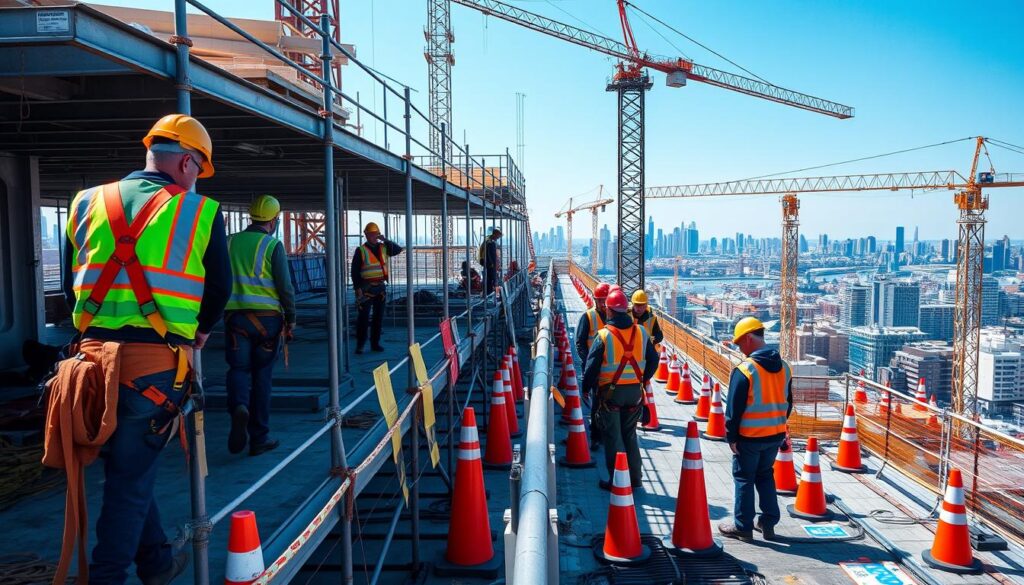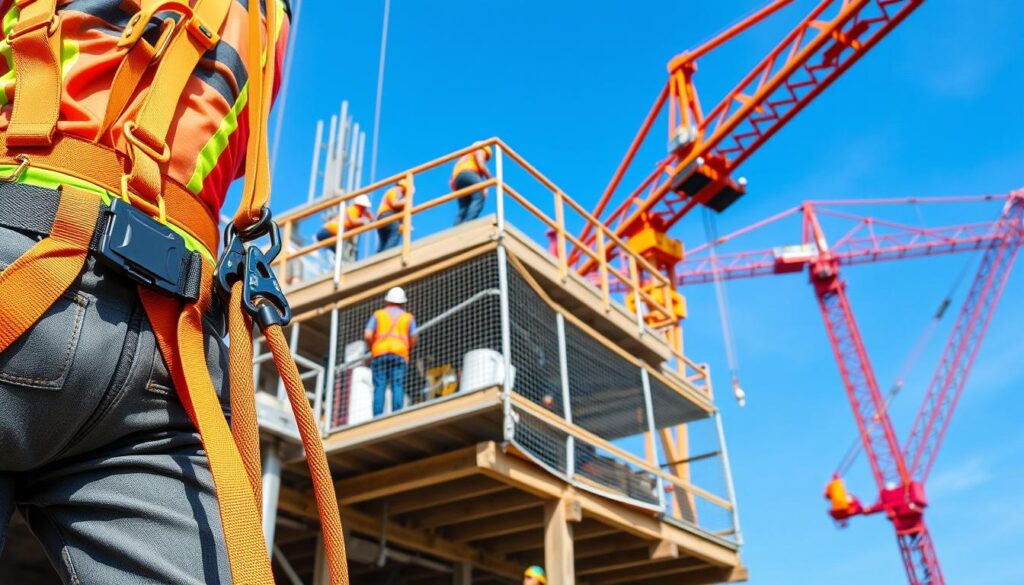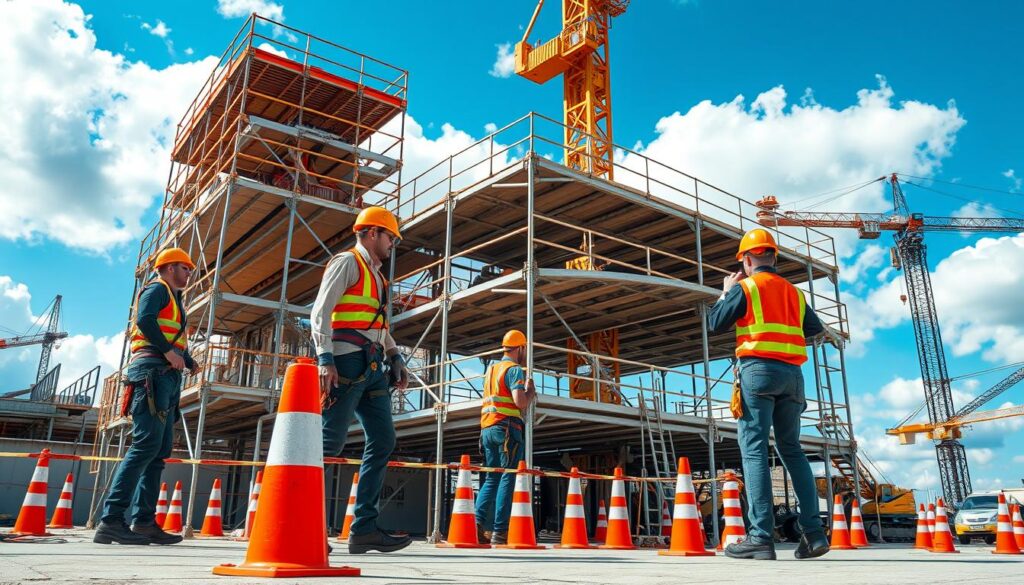As a safety professional in construction, I grasp the vital need to tackle fall hazards in construction. Falls are a major cause of injury and death on construction sites. They pose a significant risk to workers’ safety and can lead to project delays.
In this post, I will examine common fall hazards, discuss effective fall protection equipment and systems, and offer practical tips. These are aimed at preventing these dangerous incidents for construction companies and workers.

Construction work often involves working at heights, navigating uneven terrain, and dealing with hazardous equipment. These elements, along with the fast-paced nature of construction projects, increase the risk of falls. By identifying the causes of these incidents and implementing robust safety measures, we can improve worker protection. This ensures the smooth execution of construction projects.
Understanding Common Fall Hazards in Construction
Construction sites are inherently hazardous environments, with numerous risks that can jeopardize worker safety. Among the most prevalent dangers are fall hazards, which can have devastating consequences if not properly addressed.
In this section, we’ll explore the leading causes of falls on construction sites, high-risk areas, and activities, and the significant impact these incidents can have on worker safety and project timelines.
Leading Causes of Falls on Construction Sites
Falls on construction sites can be attributed to a variety of factors, including:
- Inadequate or missing safety harnesses and guardrail systems
- Unstable or uneven walking surfaces
- Insufficient lighting or poor visibility
- Lack of proper training or safety protocols
- Fatigue, distraction, or carelessness on the part of workers
High-Risk Areas and Activities
Construction sites are dynamic environments, with various areas and tasks that pose a heightened risk of falls. Some of the high-risk areas and activities include:
- Work at heights, such as roofing, scaffolding, and ladder usage
- Unprotected edges, floor openings, and stairwells
- Material handling and storage areas
- Uneven or slippery surfaces, including wet or icy conditions
- Demolition and renovation projects
Impact on Worker Safety and Project Timelines
Falls on construction sites can have severe consequences, both for the workers involved and the project as a whole.
Serious injuries, such as broken bones, head trauma, and spinal cord damage, can result in lengthy recovery times, lost productivity, and even fatalities. Moreover, these incidents can lead to project delays, increased costs, and legal or regulatory penalties, further compounding the challenges faced by construction companies.
| Injury Type | Average Recovery Time | Potential Impact on Project Timelines |
| Broken Arm | 6-8 weeks | Moderate delays, potential rescheduling of tasks |
| Traumatic Brain Injury | 6 months to 1 year | Significant delays, potential project disruption |
| Spinal Cord Injury | 1 year or more | Severe delays, potential project cancellation |
Recognizing and mitigating these construction site hazards is crucial for protecting workers and ensuring the safety of construction projects.
In the next section, we’ll explore the essential fall protection equipment and systems needed to safeguard construction workers from these risks.
Essential Fall Protection Equipment and Systems
Ensuring the safety of construction workers is a top priority, and the right fall protection equipment and systems are key. These tools are vital in protecting workers from the dangers of falls. Falls can have severe consequences on construction sites.
Personal Protective Equipment (PPE) serves as the first defense against falls. Fall protection PPE includes safety harnesses, lanyards, shock-absorbing devices, and anchorage points. It’s crucial to choose, inspect, and use these items correctly for maximum safety.
- Safety harnesses distribute the force of a fall across the worker’s body, preventing serious injuries.
- Lanyards connect the harness to an anchor point, limiting the distance of a potential fall.
- Shock-absorbing devices minimize the impact forces experienced during a fall.
- Anchorage points provide a secure attachment for the fall protection system.
Collective fall protection systems are also vital on construction sites. These include safety nets, guardrails, and warning lines. They act as barriers to prevent workers from approaching fall hazards.
- Safety netting is installed around the perimeter of a work area to catch workers in the event of a fall.
- Guardrails are physical barriers that prevent workers from falling off elevated surfaces.
- Warning lines demarcate areas where fall protection is required, alerting workers to the presence of fall hazards.
It’s essential to select, use, and maintain these fall protection systems properly. This ensures the safety of construction workers and the success of any project.

Preventing Fall Hazards: Construction Site Safety Tips
Worker safety is a top priority on any construction site. Preventing falls is a key part of this effort. By using a range of safety measures, companies can reduce the risk of accidents and delays.
Pre-Work Safety Assessments
Starting with thorough safety checks before work begins is crucial. These assessments help identify fall risks and create a plan to tackle them. They cover everything from scaffolding stability to the need for guardrails or safety nets. This groundwork is essential for a safer work environment.
Implementation of Safety Protocols
- Set up clear, enforceable safety rules that meet applicable legislation standards.
- Make sure workers have the right personal protective equipment (PPE), like safety harnesses and hard hats.
- Use effective communication to inform workers about hazards and safety rules.
- Regularly check and maintain fall protection systems to keep them working well.
Worker Training Requirements
Training workers well is key to avoiding falls. Companies should offer detailed practical training. This should include how to use fall protection gear, safe work practices, and emergency procedures. This training empowers workers to manage risks and creates a safety-focused culture.
| Safety Measure | Impact on Fall Hazard Prevention | OSHA Compliance |
| Pre-Work Safety Assessments | Identify and mitigate potential fall risks | Fulfills legislative ‘s requirement for job-site inspections |
| Comprehensive Worker Training | Equip workers with the knowledge and skills to work safely | Aligns with legislative’s training standards for fall protection |
| Effective Safety Protocols | Establish a culture of safety and accountability | Demonstrates legislative compliance through documented procedures |
By following these safety tips, companies can actively prevent falls. This protects workers and meets legislative standards. Building a strong safety culture is not just the right thing to do. It also boosts project success and efficiency.

Safety Harness Requirements and Proper Usage
Using safety harnesses correctly is key to fall protection on construction sites. These devices are crucial for protecting workers from falls. It’s important to know the requirements and guidelines for their use.
Selecting the Right Safety Harness
Choosing the right safety harness involves several factors. The harness must fit the work tasks, potential fall distance, and the worker’s size and weight. It’s vital to pick a harness that meets safety standards, and fits you properly.
Proper Fitting and Adjustment
Ensuring the harness fits right is essential. It should be snug but comfortable, with all straps and buckles secure. Workers need training to fit and adjust the harness properly, ensuring a safe and comfortable fit.
Inspection and Maintenance
Regular checks and maintenance of safety harnesses are crucial. Workers should inspect the harness before use, looking for wear or damage. Any damaged harnesses must be removed and replaced. Proper care and storage can also extend the harness’s life.
By following these guidelines, workers can reduce fall-related injuries. A comprehensive fall protection program, focusing on safety harnesses, is vital for worker safety and project success.
| Safety Harness Requirements | Proper Usage Guidelines |
| Compliance with applicable legislative regulationsAppropriate for the specific work tasks and potential fall distanceSuitable for the worker’s body size and weight | Proper fitting and adjustment for a secure and comfortable fitRegular inspection for wear, damage, or deteriorationImmediate removal and replacement of damaged or defective harnessesProper storage and care to maintain the harness’s effectiveness |
“Proper use of safety harnesses is essential to safeguard construction workers from the devastating consequences of falls from heights.”
By adhering to these guidelines and emphasizing safety harnesses, workers can improve their fall protection systems. This ensures the safety of everyone on the construction site.
Conclusion
Preventing falls on construction sites is vital for worker safety and project success. Understanding fall risks, using proper equipment, and implementing safety protocols are key. These steps help reduce fall dangers and make the work environment safer.
Following legislative standards and training, workers are critical for a safe work culture. Prioritizing safety and investing in fall prevention measures protects employees. This also boosts project efficiency and ensures compliance with regulations.
